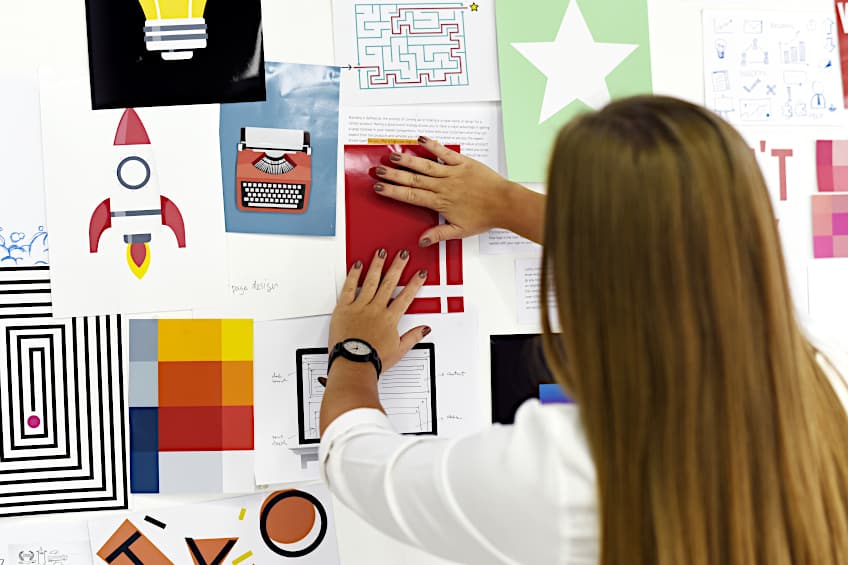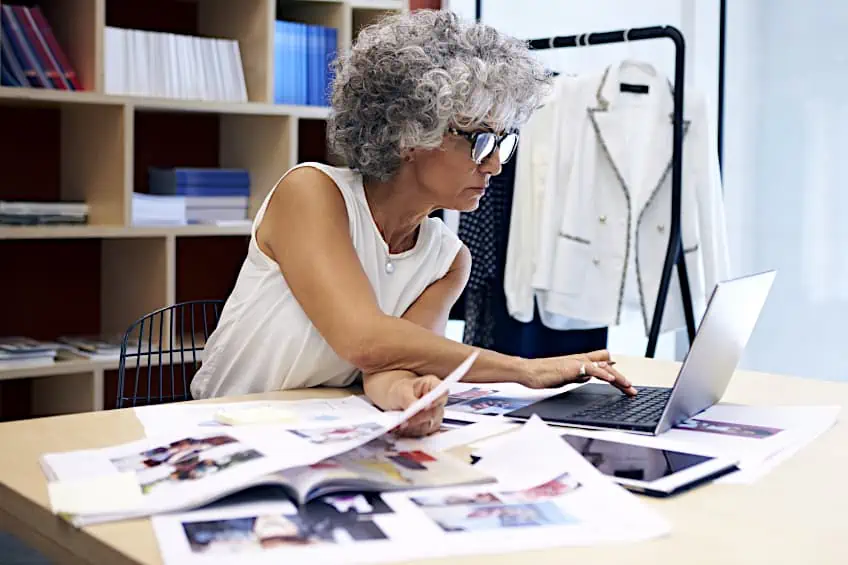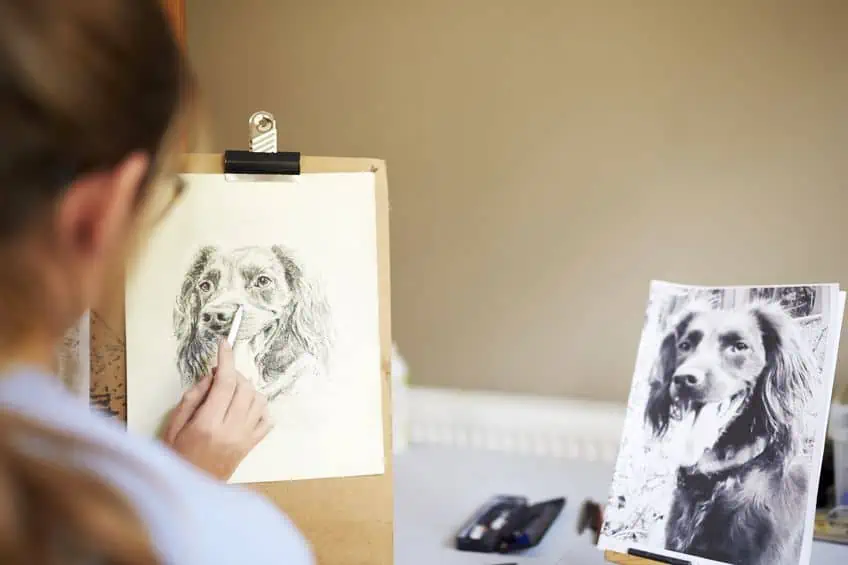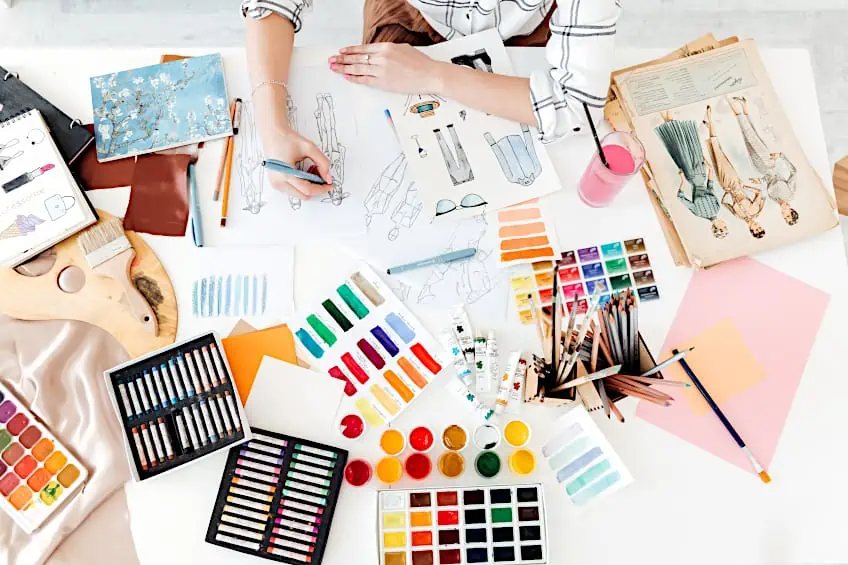Types of Illustration – Visual Communication Styles
If you have just started delving into the world of illustration, all of the different styles, terms, and techniques can be overwhelming. In this article, we explore what illustration is, the different types of illustration, as well as various illustration techniques from the traditional to the more modern ones.
What Is Illustration?
An illustration is any visual piece that is made for the purpose of explaining, clarifying, or enhancing a concept. Illustrations do not only have to be drawn, but can be in the form of a painting, photograph, collage, or even an engraving. Illustrations explain an idea or concept and can transform text into a visual representation.
Illustrations can be found in all kinds of places, from children’s storybooks to medical textbooks, and are used to make a concept more visually interesting or more clearly understood. Even event posters or signage are considered illustrations as they convey information about the event including activities, times, and even mood.
Why Use Illustrations?
Illustrations have many different benefits. They offer more originality and impact than stock images do and allow you to achieve your exact look or message, which generic images may not be able to convey. Illustrations are highly customizable and can easily be tailored to your specific needs or audience. Scientific illustrations are particularly useful as they can visually convey concepts that cannot be seen or captured in a photograph. Think about the illustrations of the earth’s core in your school textbooks and how illustrations make it easier to understand and remember the layers that you would never be able to see with your own eyes.
Illustrations are often used if photography is not enough or able to capture your concept or idea. Illustration offers you more versatility and can even be used to enhance photographs. A picture paints a thousand words and illustrations, such as infographics, can help to circumvent language and age barriers when sharing information or guidelines.
The History of Illustration
Illustrations have been used for many centuries to convey important information or events. Illustrations were a big part of early map drawing during the 15th century. Not only are maps a type of illustration that explains and describes the region it is depicting, but artists at the time also made use of the margins of maps to draw images depicting the far-off lands and their fauna and flora so that those at home could experience them.
Prior to the invention of photography, print books and other media in the 16th century used illustrations. This was particularly true for scientific journals exploring medicine or zoology, which required high levels of detail and accuracy in their drawings.
Graphic Design vs. Illustration
While they may seem similar, Graphic designers and illustrators are distinct. Graphic designers usually work with a finished object and create a composition from different elements such as images and font. A graphic designer has a more holistic role that focuses on marketing. Their main goal is to grab the attention of the target audience, draw it to a particular visual design, and leave a lasting impression all while meeting the needs of the client.
An illustrator creates the visual piece themselves and this piece is usually only supplementary to the whole product such as within an article or textbook. Illustrators offer further clarification of ideas or text and usually do not focus on the marketing aspect but rather the image itself, although they do consider the client and their needs.
Art vs. Illustration
While it does take artistic skill to create illustrations, they are not traditionally considered art. Art is made to convey the thought, feelings, and imaginations of the artist and how they perceive the world. It is not made to explain or expand upon a concept like an illustration is. The main goal of art is usually aesthetic. Illustration is created for a specific purpose with particular criteria involved, whereas you do not need a reason or rules to create art.
Main Types of Illustrations
There are many different types of illustrations that are recognized today. Illustration types refer to the style or genre of the illustration. Many artists have a preferred illustration style, however, when you work as an illustrator you will likely work on many different types of illustrations, so it is good to remain flexible.
Editorial Illustration
Editorial illustration is an illustration that is used to better showcase or explain the text it is attached to. This type of illustration adds context to existing text and often does not make much sense when viewed separately from it. You will find these kinds of illustrations in magazines and in web articles.
Advertising Illustration
Many businesses choose illustration for their advertisement if they feel photographs will not be able to capture the idea or concept of their product or service. This type of illustration is bright and bold and captures the attention of the consumer, while telling them about the product they are endorsing. Advertising illustration ideas can be with or without text and contain striking visuals or colors to promote and draw attention to a store or product. These illustration styles usually include the logo or brand name of said product or store.
Packaging Illustration
The images that you see on the outside of products are referred to as packaging illustrations. Like advertising illustrations, these also help to promote and sell a product and are therefore bold and eye-catching. Packaging illustration styles usually include the brand’s name clearly and aim to set the brand apart and make them feel unique compared to others. These illustrators are also called package designers, and need to liaise with both the client and stakeholders to create the most effective illustrations.
Concept Illustration
Using concept illustration, artists create a variety of illustration ideas based on a particular theme or concept. Also known as concept art, this style of illustration helps designers choose or refine the look of a final product. The illustrations usually progress through several stages and iterations, working with feedback and criticism to find the perfect image for the job to be based on. The term was first used in the early 20th century and is most commonly used in animation industries such as for video games or movies.
Fashion Illustration
Fashion illustration is similar to concept art only it is used for clothing design instead of character or animation. Fashion illustration is used to visualize a piece of clothing or a combination of a few pieces to see how it works before it is manufactured, used on the runway, or for promotional material.
Technical Illustration
Also known as scientific illustrations, these types of diagrams are found in textbooks or scientific journals. Technical illustrations are used to visually show complex concepts and simplify them to help you understand them. Accuracy and clarity are important in these illustrations and looks are secondary, however, it is still important that they are visually interesting and appealing.
Technical illustrations can be in reference to text or stand alone, can contain text or labels but can also have a short paragraph under the image that further elaborates on it. Mechanical and medical illustrations form a sub-category of this type of illustration.
Forensic Illustrator
Forensic sketch artists can be employed to help identify criminals from victims’ or witnesses’ descriptions. In combination with police, they use specialized communication skills to get the most accurate description of people and events quickly and clearly to provide detailed representative work that can be used in identifications, scene reconstructions, etc., to aid in solving criminal cases.
Infographics
Infographics are illustrations centered on delivering information quickly and clearly. Infographics can break down a lot of information into an easy-to-understand illustration, and often they contain images and diagrams that demonstrate or explain a phenomenon or topic.
Children’s Illustration
This particular type of illustration style is very diverse and ranges from more simple illustration styles in line art to detailed scenes. They do, however, have a few key things in common. Children’s illustrations tend to be bright and attractive with rich colors and characters that are friendly and expressive. In children’s illustrations, something is always going on and they are often linked to actions in surrounding text.
Comic and Graphic Novel Illustration
Like children’s illustration, each comic or graphic has its own unique style however they have some common characteristics. This type of illustration is exciting and engaging and is often accompanied by pops of dialogue and actions, which add to the story the illustration is trying to tell. Book cover illustrations need to be eye-catching and stand out on a bookshelf of hundreds of other books while also hinting to the potential reader about what awaits them inside.
Different Illustration Techniques
The techniques you use will largely depend on the purpose of your illustration. Illustration technique refers to the medium and general style of illustration used in the piece. An illustration can be done in many mediums including traditional styles of illustration such as pencil, paint, and ink, as well as more modern illustration styles done on digital apps and programs.
Traditional Illustration Techniques
Traditional illustration techniques have been around for a very long time. The earliest of these techniques were seen in cave paintings over 10 000 years old, and many more new techniques have evolved in the centuries since. Traditional techniques use traditional tools and mediums such as paints, pencils, and wood to create illustrations.
Drawing Techniques
Drawing is the oldest illustration technique and contains many different techniques. Many illustration artists still draw their pieces with graphite and colored pencils and use different line weights and hardness to create unique illustrations. Graphite pencils are used to create simple illustration styles and remain the most common medium used when sketching illustrations before finishing them in their final material.
Charcoal is another traditional illustration medium used to draw. While not as precise as pencils, charcoal allows the artist to create quick sketches that are filled with more texture and depth that a pencil would take time to build up. Charcoal can easily be blended to create different effects and shadows for a bold illustration.
Ink
Similar to pencil and charcoal, ink has been used to create illustrations for hundreds of years. Inks provide a stark contrast and bold colors; however, they can be unforgiving and are not recommended for beginner illustrators. Today different pen thicknesses and ink finishes make it a versatile medium for illustration work.
Woodcutting
Woodcutting is a very old illustration technique that involves carving the illustration into a wood block. This technique became especially popular after the invention of the printing press during the Middle Ages. The printing press allowed these wood blocks to be used as stamps to add detailed images to mass-produced books. This is not a simple illustration technique as it not only requires artistic skill but also a knowledge of the material and tools. Modern printmakers often substitute the wood block with sheets of linoleum to create linocut prints. The effect is similar, but costs much less to produce.
Metal Etching
Similar to woodcutting is another traditional illustration technique called metal etching. This method involves coating a metal plate, usually made of copper, steel, or zinc, in an acid-resistant coating. The image is then etched into the wax, exposing the metal below. The plate is then dipped into acid and the exposed metal is corroded, leaving behind a sunken image on the metal’s surface. Once the wax has been cleaned off the plate, it is coated in ink and then wiped off to create an ink stamp that can be transferred to a sheet of paper or canvas.
Paint
Artists use a variety of paints for illustration however the most popular painting mediums are acrylic and watercolor paints. Watercolors give a light, soft effect and are usually used for children and feminine-focused illustrations or even cookbooks. Acrylics are often used by beginner illustrators as it is not only very forgiving and easy to work with, but also offers brilliant color and versatility. Acrylic paints are long-lasting, and you can use them to create illustrations on multiple surfaces from clay pots to canvas.
Collage
This illustration technique entails combining different elements into a unique whole. Many collages are made from multiple mediums, not just one. This allows the artist to achieve a three-dimensional depth in their piece. Collage has become more popular in recent years for illustrations as it gives your piece lots of visual interest.
Modern Illustration Techniques
With advancements in technology, new methods of creating art and illustrations have developed. Digital techniques imitate traditional methods and allow for easier editing and post-processing effects.
Freehand Digital Illustrations
Drawing tablets are widely used by illustrators to create their designs digitally. These tablets can be drawn on with styluses just as you would draw on paper or canvas. Drawing tablets are highly versatile and beginner friendly. The virtual brushes also come in many different sizes and effects and the apps allow you to edit each layer of the illustration separately and even undo mistakes. There are many Apps that allow you to create digital illustrations including Photoshop, Illustrator, 3DMax, and others.
Vector Illustrations
In vector illustrations, every point of the illustration is connected to a coordinate on an axis to show its position and direction. This modern illustration technique allows you to Easily transfer your image, scale it up or down, or rotate it without it pixelating. Vector illustration is mainly used for illustrations on web pages but offers less detail than freehand digital illustrations.
Mixed illustration techniques are also used, especially in multistage illustration development. Concept and fashion illustration is often drawn in pencil first and once it is more fleshed out moves to digital processing.
Illustrations offer a powerful mechanism for storytelling, advertising, and information relaying through images. They have become an important asset in our daily lives, and offer a broad array of benefits across their very different illustration techniques and styles!
Frequently Ask Questions
What Is Illustration?
An illustration is an image made to convey a message or information. Different types of illustrations are used in different industries to convey various ideas, concepts, and information. Examples of illustrations include informatics, scientific diagrams, and concept sketches.
What Is the Difference Between Illustrations and Art?
Art drawings are usually made to satisfy an artist’s goal or wish for expression, and have no limiting rules or constraints beyond achieving their aesthetic purpose. Illustrations are not considered art in the traditional sense because they are created with the express objective of relaying information or expanding upon a concept.
What Are the Main Illustration Techniques?
Illustration techniques refer to the medium or overall style used to create the illustration. There are two main categories of illustrations, namely traditional and modern techniques. Traditional techniques have been used for many years and include drawing with pencils and ink, woodcutting, and metal etching. Modern techniques are relatively young compared to traditional ones and mimic them, as well as include digital drawing and vector illustrations.
Jordan Anthony is a Cape Town-based film photographer, curator, and arts writer. She holds a Bachelor of Art in Fine Arts from the University of the Witwatersrand, Johannesburg, where she explored themes like healing, identity, dreams, and intuitive creation in her Contemporary art practice. Jordan has collaborated with various local art institutions, including the KZNSA Gallery in Durban, the Turbine Art Fair, and the Wits Art Museum. Her photography focuses on abstract color manipulations, portraiture, candid shots, and urban landscapes. She’s intrigued by philosophy, memory, and esotericism, drawing inspiration from Surrealism, Fluxus, and ancient civilizations, as well as childhood influences and found objects. Jordan is working for artfilemagazine since 2022 and writes blog posts about art history and photography.
Learn more about Jordan Anthony and about us.
Cite this Article
Jordan, Anthony, “Types of Illustration – Visual Communication Styles.” artfilemagazine – Your Online Art Source. March 20, 2023. URL: https://artfilemagazine.com/types-of-illustration/
Anthony, J. (2023, 20 March). Types of Illustration – Visual Communication Styles. artfilemagazine – Your Online Art Source. https://artfilemagazine.com/types-of-illustration/
Anthony, Jordan. “Types of Illustration – Visual Communication Styles.” artfilemagazine – Your Online Art Source, March 20, 2023. https://artfilemagazine.com/types-of-illustration/.






















